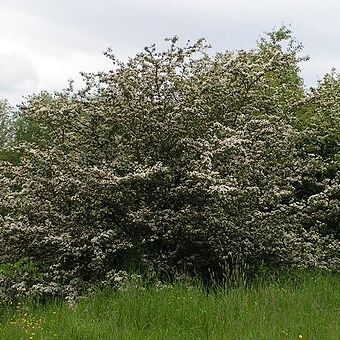Fls perfect, regular, in compound or nearly simple cymes, or rarely solitary; pet 5, white, rarely pink or red; sep 5, entire or glandular-serrate; stamens 5–25, arranged alternately in 1–5 rows; ovary inferior or free at the tip, the 1–5 carpels with as many persistent free styles; fr a small, globose to ovoid or pyriform pome, usually red or reddish, sometimes yellow, greenish, or blue-black, with 1–5 bony, usually 1-seeded nutlets; small trees or shrubs with usually thorny and often flexuous branches; lvs simple, deciduous, toothed and often also lobed, those of the flowering branches (the floral lvs) often unlike those of strictly vegetative branches; x=16, 17. Our spp. all fl in the spring and fr in the fall. 100+, N. Temp. and Andes.The spp. of Crataegus characteristically occur in disturbed sites or seral communities, such as pastures, edges of the forest, open second-growth woods, and thickets along streams. It has not been considered necessary to repeat these comments on the habitat for each species in the following text.The taxonomy of Crataegus is complicated by hybridization, polyploidy, aneuploidy, and apomixis. Several hundred species have been described from our range alone. A proper understanding of the group will require a thorough biosystematic study; the treatment here presented is rough and more than ordinarily tentative. Some names suspected or believed to apply to hybrids or plants of hybrid origin are listed before the key to accepted species.C. ×anomala Sarg. = C. coccinea × mollisC. ×apiomorpha Sarg. = C. coccinea × flabellataC. ×ardua Sarg. = C. punctata × succulentaC. ×aulica Sarg. = C. coccinea × dilatataC. ×celsa Sarg. = C. punctata × succulentaC. ×chadsfordiana Sarg. = C. pruinosa × succulentaC. ×collicola Ashe = C. crus-galli × punctataC. ×corusca Sarg. = C. coccinea × mollisC. ×danielsii E. J. Palmer = C. crus-galli × punctataC. ×densiflora Sarg. = C. flabellata × rotundifoliaC. ×desueta Sarg. = C. brainerdii × punctataC. ×disperma Ashe = C. crus-galli × punctataC. ×divida Sarg. = C. brainerdii × succulentaC. ×durobrivensis Sarg. = C. pruinosa × punctata C. ×ellwangeriana Sarg. = C. coccinea × mollis [Continued]
Deciduous shrubs or small trees, usually armed with spines; stems erect to spreading, sometimes with well developed trunk; young stems glabrous or pilose. Lvs either distributed along stems or in fascicles, simple, lobed to pinnatifid with margins serrate or entire, usually petiolate; lvs of non-flowering first-year shoots usually larger and broader at base than those of flowering shoots; stipules larger, persistent and somewhat leafy on long vegetative shoots, smaller and deciduous on older and shorter shoots. Infl. usually a flattened or rounded corymb of many small but showy fls terminating a leafy short shoot, rarely fls 1-3 in fascicles. Fls 5-merous, ☿, pedicellate. Hypanthium tubular, closed at apex. Epicalyx 0. Calyx of 5 sepals; sepals short, fused at base, generally persistent, sometimes deciduous. Petals 5, often suborbicular and spreading, usually white, occasionally pink, cream or red. Stamens 5-25. Ovary semi-inferior or inferior, sunken in hypanthium; carpels 1-5, connate on inner margin at least near base; styles 1-5; ovules 2 in each locule. Fr. pome-like, usually rather small, red, yellow, blue-black or black, globose to ovoid or ovoid-ellipsoid, with ± mealy flesh and 1-5 (rarely more), woody carpels each containing 1 seed.
[Continued; 3rd section]C. ×laneyi Sarg. = C. brainerdii × succulenta C. ×laurentiana Sarg. = C. rotundifolia × succulentaC. ×lecta Sarg. = C. mollis × pruinosaC. ×lettermanii Sarg. = C. mollis × punctata C. ×littoralis Sarg. = C. intricata × pruinosa C. ×locuples Sarg. = C. mollis × pruinosaC. ×lucorum Sarg. = C. coccinea × flabellataC. ×mansfieldensis Sarg. = C. coccinea × punctataC. ×media Sarg. = C. flabellata × pruinosaC. ×membranacea Sarg. = C. pruinosa × succulentaC. ×menandiana Sarg. = C. punctata × succulentaC. ×merita Sarg. = C. coccinea × flabellataC. ×neobaxteri Sarg. = C. punctata × rotundifolia C. ×nitida (Engelm) Sarg. = C. crus-galli × viridis C. ×nitidula Sarg. = C. punctata × rotundifoliaC. ×nuda Sarg. = C. crus-galli × succulentaC. ×pausiaca Ashe = C. crus-galli × punctataC. ×persimilis Sarg. = C. crus-galli × succulentaC. ×pilosa Sarg. = C. intricata × pruinosa [Continued]
[Continued; 2nd section.]C. ×formosa Sarg. = C. flabellata × pruinosa C. ×fretalis Sarg. = C. coccinea × flabellataC. ×glareosa Ashe = C. pruinosa × succulentaC. ×haemocarpa Ashe = C. flabellata × pruinosaC. ×harryi Sarg. = C. brainerdii × punctataC. ×hirtiflora Sarg. = C. mollis × punctataC. ×ideae Sarg. = C. brainerdii × rotundifoliaC. ×illecebrosa Sarg. = C. coccinea × coccinioides×immanis Ashe = C. pruinosa × rotundifoliaC. ×improvisa Sarg. = C. brainerdii × coccineaC. ×incaedua Sarg. = C. calpodendron × punctataC. ×integriloba Sarg. = C. punctata × succulentaC. ×kellermanii Sarg. = C. pruinosa × punctataC. ×kelloggii Sarg. = C. mollis × rotundifoliaC. ×kennedyi Sarg. = C. brainerdii × pruinosaC. ×kingstonensis Sarg. = C. brainerdii × coccinioidesC. ×knieskerniana Sarg. = C. coccinea × flabellataC. ×laetifica Sarg. = C. crus-galli × succulenta [Continued]
[Continued; 4th section.]C. ×puberis Sarg. = C. flabellata × punctataC. ×putata Sarg. = C. pruinosa × succulentaC. ×randiana Sarg. = C. brainerdii × flabellata C. C. ×rotundata Sarg. = C. pruinosa × rotundifolia C. ×rubrocarnea Sarg. = C. brainerdii × flabellata C. ×shirleyensis Sarg. = C. brainerdii × punctata C. ×silvestris Sarg. = C. pruinosa × punctataC. ×spatiosa Sarg. = C. pruinosa × succulentaC. ×vailiae Britton = C. calpodendron × unifloraC. ×vittata Ashe = C. coccinea × flabellataC. ×websteri Sarg. = C. brainerdii × calpodendron C. ×whitakeri Sarg. = C. calpodendron × mollisC. ×xanthophylla Sarg. = C. coccinea × flabellata [Continued]
Shrubs, subshrubs, or small trees, deciduous, rarely evergreen, armed, rarely unarmed; buds ovoid or subglobose. Leaves simple, stipulate, venation craspedodromous, margin serrate and lobed or partite, rarely entire. Inflorescences corymbose, sometimes flowers solitary. Hypanthium campanulate. Sepals 5. Petals 5, white, rarely pinkish. Stamens 5–25; carpels 1–5, connate, but free apically. Ovary inferior or semi-inferior, with 2 ovules per locule, but one rudimentary. Fruit a pome, with persistent sepals at apex; carpels bony when mature, each locule with 1 seed; seed erect, cotyledons plano-convex.


